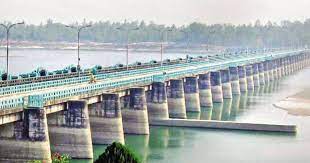Monitoring Desk
DHAKA: Bangladesh has expressed its concerns at India’s plan to divert waters from the river Teesta by digging two more canals and setting up two hydropower plants upstream in its West Bengal state.
Known scholar Prof Dr Ashok Swain taking to Twitter highlighted the issue saying Bangladesh terms the water diversion from Teesta by India is alarming.
According to the news reports, West Bengal’s irrigation department had taken possession of approximately 1,000 acres of land to dig two more canals under the Teesta Barrage Project to channel water for agricultural purposes.
Under the new project, India will build three hydropower plants in Darjeeling, two of which will draw water from the Teesta River.
Bangladesh is prepared to write to India asking for an explanation and for details about the projects that the Indian government has launched to dig canals to divert water from the joint river for agricultural use.
Bangladesh minister for water resources Zahid Faruk said that these reports are alarming, we know nothing about it officially, and that is why we are going to send a letter to the Indian government seeking clarification.
The 414 km (257 miles) Teesta River originates in the eastern Himalayas and crosses northern Bangladesh.
Bangladesh has 57 transboundary rivers, 54 of which are shared with India and three with Myanmar.
Bangladesh will send a letter to India to seek an explanation for the diversion of the river.
During the upcoming visit of Bangladesh Prime Minister Sheikh Hasina to India, from April 7-10, the most important issue the two countries are expected to discuss is the deal on releasing about 48% of the waters from the Teesta river to Bangladesh.
Teesta is the fourth largest transboundary river shared between India and Bangladesh, after the Ganges, Brahmaputra and the Meghna (GBM) river system. The total catchment area of the GBM is about 1.75 million square km. The Teesta originates in the Indian state of Sikkim and its total length is 414 km, out of which 151 km lie in Sikkim, 142 kms flow along the Sikkim-West Bengal boundary and through West Bengal, and 121 km run in Bangladesh. In Bangladesh, the river mainly affects the five northern districts of Rangpur Division: Gaibandha, Kurigram, Lalmonirhat, Nilphamari and Rangpur.
According to a report, the plain covers about 14% of the total cropped area of Bangladesh and provides direct livelihood opportunities to approximately 7.3% of its population.
Bangladesh officials said that the river usually provides water for irrigation to 55,000 hectares of agricultural land during the dry season, but this year it has only provided water to 35,000 hectares due to a lack of water flow in the Teesta River and other renovation work in canals of the Teesta barrage project.
The Teesta Barrage, located 44 km (27 miles) northeast of Nilphamari, began operation in 1979.
They said the river nearly dried up during the dry season due to irrigation and water control upstream in India. If the waters are diverted further, the entire ecosystem in the Teesta downstream will suffer, they added.







